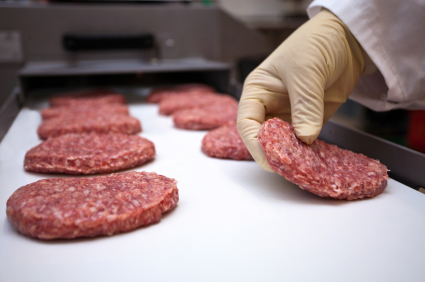 Michelle Obama’s anti-childhood obesity agenda would have kids a little less round ’round the middle.White House Flickr streamWhile we await Michelle Obama’s speech this Wednesday to the United States Conference of Mayors that will likely launch her new campaign against childhood obesity, I thought I’d offer a little perspective as well as a few bits of research that shed light on the enormity and complexity of the obesity epidemic.
Michelle Obama’s anti-childhood obesity agenda would have kids a little less round ’round the middle.White House Flickr streamWhile we await Michelle Obama’s speech this Wednesday to the United States Conference of Mayors that will likely launch her new campaign against childhood obesity, I thought I’d offer a little perspective as well as a few bits of research that shed light on the enormity and complexity of the obesity epidemic.
First off, let’s be clear: The First Lady will, of course, do everything she can to avoid picking a fight with Big Food — I wouldn’t be surprised to see corporate partnerships coming out of her efforts. Indeed, her team’s first foray into the food policy arena, which included rumors of a White House embrace of former FDA Commissioner David Kessler’s “junk food addiction” model for obesity, the president himself raising the possibility of a soda tax and the somewhat defensive posture of her policy team in an interview with NPR, were overshadowed by industry objections.
Even the most common-sense advice from her (drink water not soda, eat less processed food) prompted howls of outrage from food companies. We’ll know for sure next week, but school food will probably be the focus of all her efforts. After all, school food is already the government’s responsibility and even in the “reform-proof” Senate there is a fair amount of momentum for reducing access to junk food in the lunchroom and improving the quality of school food.
Unfortunately, the school environment is not the only one at issue for kids. I wrote back in September about a Temple University study which showed corner stores to be a scourge to school nutritionists:
[R]esearchers perform[ed] voluntary inspections for students’ purchases — most obesity studies rely on self-reporting, which is notoriously unreliable. And what’s inside those before- and after-school shopping bags is pretty depressing. One researcher saw an eighth-grader’s $1.80 haul — a Coke, chips, and piece of chocolate cake. 500 calories — calorically (though not nutritionally) equal to the lunch served that day at school. These lunches are free to most students as the school in question participates in Philly’s Universal Feeding program. As the article points out, the hard work that went into getting junk food out of these Philly schools is being almost totally undermined.
But it’s not just corner stores. A study just published in the American Journal of Public Health surveyed all kinds of non-food stores in 19 US cities — small, medium and large — to see how many sold calorically-dense snack foods.
Snack food was available in 41 percent of the stores; the most common forms were candy (33 percent), sweetened beverages (20 percent), and salty snacks (17 percent). These foods were often within arm’s reach of the cash register queue. We observed snack foods in 96 percent of pharmacies, 94 percent of gasoline stations, 22 percent of furniture stores, 16 percent of apparel stores, and 29 to 65 percent of other types of stores. Availability varied somewhat by region but not by the racial or socioeconomic characteristics of nearby census tracts.
Junk food really is everywhere! The researchers noted that people don’t reduce their overall eating patterns to account for snacking and thus the more “eating occasions” a person has, the higher their caloric intake will be. They also observed that FDA regulations allow anyone to sell candy, soda, and salty snacks. But if you want to sell fruits and vegetables? You need a permit. Big Food strikes again.
And yet, even attacking calories consumed (as the First Lady will undoubtedly do) may prove insufficient. There are more and more indications that the industrial chemical soup that surrounds us plays a role as well. There is strong evidence that phthalates, an ingredient in soft plastic toys as well as in personal care products, are a factor in the obesity epidemic, especially in low-income communities.
And now a new study finds that Persistent Organic Pollutants (POPs) such as certain pesticides as well as chemicals like dioxin and PCBs, when consumed at levels commonly found in food, can cause insulin resistance (which can lead to diabetes, obesity and liver disease). Many kinds of POPs have been banned here and abroad but they can persist for decades in the environment and in our food. We’ll be eating PCBs for a long time to come. It’s the first study that has established this link experimentally. Here’s how they did it:
Adult male rats were fed for 28 days either crude or refined fish oil obtained from farmed Atlantic salmon carcasses.
The crude fish oil contained the levels of POPs that people are typically exposed to after eating the fish. The refined fish oil contained no POPs and was fed to the control rats. The levels of fat in both diets were the same.
Adult rats exposed to the crude fish oil — which contained the POPs mixture — put on belly fat and developed insulin resistance and liver disease. The rats could not regulate fat properly. They had higher levels of cholesterol and the fatty acids triacylglycerol and diacylglycerol in their livers.
In contrast, none of these changes were seen in the rats that ate fish oil without the POPs.
Although blood levels of insulin and sugar were similar among rats with either diet, the rats exposed to POPs had impaired insulin action. The POPs also altered the expression of number of genes involved in metabolism, which could explain the changes in fat and sugar regulation.
Let’s parse this. They fed the rats fish oil “obtained from farmed Atlantic salmon carcasses.” You, too, could perform this experiment on yourself — go to the supermarket and buy Atlantic salmon. Then eat it. Congratulations! You just exposed yourself to Persistant Organic Pollutants! Now, you can argue that people don’t eat just crude fish oil for months at a time — but POPs bioaccumulate in all sorts of foods. And it’s very interesting that both sets of animals displayed similar blood sugar and insulin levels — it was how their bodies responded to the insulin that changed.
Of greatest concern was the evidence that the POP exposure “altered the expression of number of genes involved in metabolism.” Scary stuff — these pollutants are affecting us on a genetic level. And no doubt, some people will respond differently to these pollutants than others based on their genetic makeup.
In fact, I recently ran across a study of the link between pesticides and Parkinson’s disease that demonstrated this affect. According to the study, a particular gene has now been linked to increased risk from developing Parkinson’s after prolonged exposure to organophosphate pesticides. This may seem obscure (and unrelated to the subject of this post) but it has serious implications. There’s nothing in our toxic chemical regulations that would account for increased risk via genetic predispositions in a particular population. What if a chemical is benign to most people but a serious health risk to others — and we have no way of knowing who’s at risk? What do we do then? Under current regulations, the government is unlikely to act.
So, we’re left with an obesity epidemic which has certainly been caused in part by increased caloric intake, but increasingly appears to have been caused in part by our genetic response to all sorts of environmental factors. I’m as curious as anyone to hear the elements of the First Lady’s plan to combat childhood obesity and I expect to hear good ideas about getting junk food out of schools and enlisting parents in the work of establishing good nutrition. But I also hope she’s thinking about how to deal with the chemicals in our food which may be altering our childrens’ genes as well as their weight.



